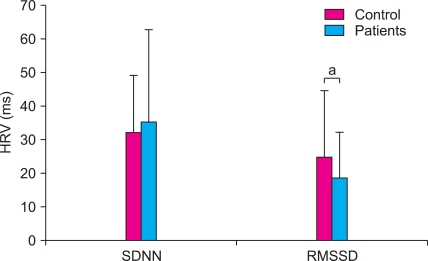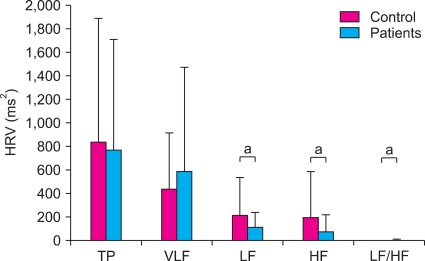Korean J Urol.
2010 Mar;51(3):183-186.
Autonomous Nervous System Activity in Women with Detrusor Overactivity
- Affiliations
-
- 1Department of Urology, Ajou University School of Medicine, Suwon, Korea. urochoi@ajou.ac.kr
- 2Department of Biochemistry and Molecular Biology, Ajou University School of Medicine, Suwon, Korea.
- 3Department of Urology, The Catholic University of Korea College of Medicine, Seoul, Korea.
Abstract
- PURPOSE
To identify autonomic dysfunction among patients with urinary incontinence (UI) with or without detrusor overactivity (DO), we measured and compared heart rate variability (HRV) in these groups. MATERIALS AND METHODS: We studied HRV in 12 female UI patients with DO (mean age, 57.3+/-11.0 years) and 53 female UI patients without DO (mean age, 56.8+/-9.8 years). HRV parameters were measured by SA-3000P(R). Heart rates, the time domain index, and the frequency domain index were compared. To compare time domain indexes, we used the standard deviation of the N-N interval (SDNN), the square root of the mean squared differences of successive N-N intervals (RMSSD), and the frequency domain indexes total power (TP), very low frequency (VLF), low frequency (LF), high frequency (HF), and the low-frequency/high-frequency ratio (LF/HF ratio). RESULTS: RMSSD values were lower in UI patients with DO than in those without DO, but the values of SDNN and HR showed no significant difference. Whereas the values of LF and HF were lower in UI patients with DO than in those without DO, the LF/HF ratio was higher. TP and VLF were not significantly different. CONCLUSIONS: RMSSD, HF, and LF were lower in DO patients than in controls without DO, but the LF/HF ratio was higher. This suggests that both sympathetic and parasympathetic activity is attenuated in DO, but the autonomic imbalance is higher.
Keyword
Figure
Reference
-
1. Abrams P, Cardozo L, Fall M, Griffiths D, Rosier P, Ulmsten U, et al. The standardisation of terminology in lower urinary tract function: report from the standardisation sub-committee of the International Continence Society. Urology. 2003; 61:37–49. PMID: 12559262.
Article2. Won YY, Kim YS, Choi JB. The clinical role of cystourethrography and urodynamic study in patients with stress urinary incontinence. Korean J Urol. 2004; 45:120–124.3. Hirsch JA, Bishop B. Respiratory sinus arrhythmia in humans: how breathing pattern modulates heart rate. Am J Physiol. 1981; 241:H620–H629. PMID: 7315987.
Article4. Hubeaux K, Deffieux X, Ismael SS, Raibaut P, Amarenco G. Autonomic nervous system activity during bladder filling assessed by heart rate variability analysis in women with idiopathic overactive bladder syndrome or stress urinary incontinence. J Urol. 2007; 178:2483–2487. PMID: 17937953.
Article5. Luczak H, Laurig W. An analysis of heart rate variability. Ergonomics. 1973; 16:85–97. PMID: 4702067.
Article6. Yoshimura N, Chancellor MB. Current and future pharmacological treatment for overactive bladder. J Urol. 2002; 168:1897–1913. PMID: 12394674.
Article7. Kleiger RE, Miller JP, Bigger JT Jr, Moss AJ. Decreased heart rate variability and its association with increased mortality after acute myocardial infarction. Am J Cardiol. 1987; 59:256–262. PMID: 3812275.
Article8. Malik M, Farrell T, Cripps T, Camm AJ. Heart rate variability in relation to prognosis after myocardial infarction: selection of optimal processing techniques. Eur Heart J. 1989; 10:1060–1074. PMID: 2606116.
Article9. Bigger JT Jr, Fleiss JL, Steinman RC, Rolnitzky LM, Kleiger RE, Rottman JN. Frequency domain measures of heart period variability and mortality after myocardial infarction. Circulation. 1992; 85:164–171. PMID: 1728446.
Article10. Brading AF, Turner WH. The unstable bladder: towards a common mechanism. Br J Urol. 1994; 73:3–8. PMID: 8298896.
Article11. Steers WD, Ciambotti J, Etzel B, Erdman S, de Groat WC. Alterations in afferent pathways from the urinary bladder of the rat in response to partial urethral obstruction. J Comp Neurol. 1991; 310:401–410. PMID: 1723990.
Article12. Task Force of the European Society of Cardiology and the North American Society of Pacing and Electrophysiology. Heart Rate Variability. Standards of measurement, physiological interpretation, and clinical use. Eur Heart J. 1996; 17:354–381. PMID: 8737210.13. Sayers BM. Analysis of heart rate variability. Ergonomics. 1973; 16:17–32. PMID: 4702060.
Article14. Hon EH, Lee ST. Electronic evaluation of the fetal heart rate. Viii. Patterns Preceding Fetal Death, Further Observations. Am J Obstet Gynecol. 1963; 87:814–826. PMID: 14085784.15. Koizumi K, Terui N, Kollai M. Effect of cardiac vagal and sympathetic nerve activity on heart rate in rhythmic fluctuations. J Auton Nerv Syst. 1985; 12:251–259. PMID: 3998390.
Article16. Katona PG, Jih F. Respiratory sinus arrhythmia: noninvasive measure of parasympathetic cardiac control. J Appl Physiol. 1975; 39:801–805. PMID: 1184518.
Article17. Akselrod S, Gordon D, Ubel FA, Shannon DC, Berger AC, Cohen RJ. Power spectrum analysis of heart rate fluctuation: a quantitative probe of beat-to-beat cardiovascular control. Science. 1981; 213:220–222. PMID: 6166045.
Article18. Appel ML, Berger RD, Saul JP, Smith JM, Cohen RJ. Beat to beat variability in cardiovascular variables: noise or music? J Am Coll Cardiol. 1989; 14:1139–1148. PMID: 2681319.
Article19. Kamath MV, Fallen EL. Power spectral analysis of heart rate variability: a noninvasive signature of cardiac autonomic function. Crit Rev Biomed Eng. 1993; 21:245–311. PMID: 8243093.20. Montano N, Ruscone TG, Porta A, Lombardi F, Pagani M, Malliani A. Power spectrum analysis of heart rate variability to assess the changes in sympathovagal balance during graded orthostatic tilt. Circulation. 1994; 90:1826–1831. PMID: 7923668.
Article21. Antelmi I, de Paula RS, Shinzato AR, Peres CA, Mansur AJ, Grupi CJ. Influence of age, gender, body mass index, and functional capacity on heart rate variability in a cohort of subjects without heart disease. Am J Cardiol. 2004; 93:381–385. PMID: 14759400.
Article22. Choi CJ, Choi WS, Kim KS. The changes in heart rate variability between morning and afternoon. J Korean Acad Fam Med. 2008; 29:579–584.23. Lowe EM, Anand P, Terenghi G, Williams-Chestnut RE, Sinicropi DV, Osborne JL. Increased nerve growth factor levels in the urinary bladder of women with idiopathic sensory urgency and interstitial cystitis. Br J Urol. 1997; 79:572–577. PMID: 9126085.
Article24. Choi JB, Kim YB, Kim BT, Kim YS. Analysis of heart rate variability in female patients with overactive bladder. Urology. 2005; 65:1109–1112. PMID: 15923026.
Article25. Kim IH, Kim JT, Lee SH, Kim SJ, Kim YS, Choi JB. The relation between autonomic nervous system activity and lower urinary tract symptoms: an analysis of heart rate variability in men with lower urinary tract symptoms. Korean J Urol. 2009; 50:475–479.
Article26. Cha MH, Kim YS, Choi JB. Analysis of heart rate variability in patients with urgency. J Korean Continence Soc. 2004; 8:119–123.
Article
- Full Text Links
- Actions
-
Cited
- CITED
-
- Close
- Share
- Similar articles
-
- Comparison between Natural Filling Cystometry and Conventional Retrograde Filling Cystometry in Patients with Stroke
- The Etiology and Classification of Nocturia in Adults
- Alteration of Autonomic Function in Female Urinary Incontinence
- Efficacy and Adverse Events Associated With Use of OnabotulinumtoxinA for Treatment of Neurogenic Detrusor Overactivity: A Meta-Analysis
- Semiconditional Electrical Stimulation of Pudendal Nerve Afferents Stimulation to Manage Neurogenic Detrusor Overactivity in Patients with Spinal Cord Injury



